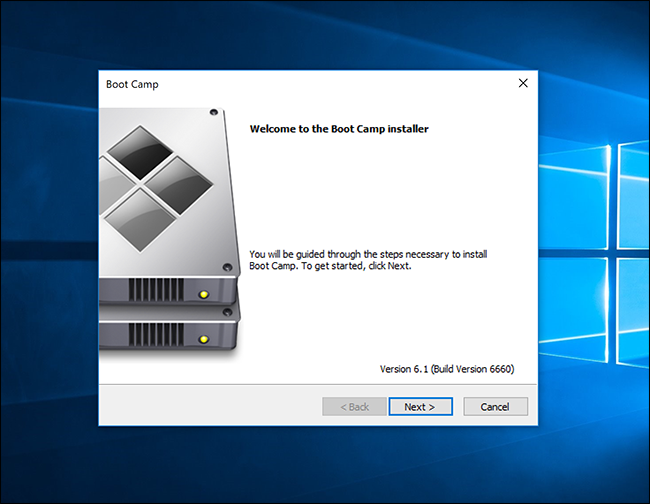Sep 30, 2015 Question: Q: bootcamp partition not showing up in El Capitan I just upgraded to OS X El Capitan, however, my windows partition is not showing up either in disk utility or start up menu. https://ninrealty.netlify.app/dev-c-dyntlsinitcallback.html. I see that my mac partition is still the same size as i left it (500 GB) while its missing the windows partition (250 GB).

Boot Camp Control Panel User Guide
You can set the default operating system to either macOS or Windows. The default operating system is the one you want to use when you turn on or restart your Mac.
Set the default operating system
In Windows on your Mac, click in the right side of the taskbar, click the Boot Camp icon , then choose Boot Camp Control Panel.
If a User Account Control dialog appears, click Yes.
Select the startup disk that has the default operating system you want to use.
If you want to start up using the default operating system now, click Restart. Otherwise, click OK.
You can’t change your startup volume to an external FireWire or USB drive while you’re using Windows.
To learn how to change the default operating system using macOS, see Get started with Boot Camp.
Restart in macOS
In Windows on your Mac, do one of the following:
Xfer Serum Crack Overview Of Serum Crack: –Xfer Company creates Xfer Serum Crack. Serum vst download mega.
Restart using Startup Manager: Restart your Mac, then immediately press and hold the Option key. When the Startup Manager window appears, release the Option key, select your macOS startup disk, then press Return.
If you’re using a portable Mac with an external keyboard, make sure you press and hold the Option key on the built-in keyboard.
Restart using Boot Camp Control Panel: Click in the right side of the taskbar, click the Boot Camp icon , then choose Restart in macOS.
This also sets the default operating system to macOS.
For more information about restarting in macOS, see the Apple Support article Switch between Windows and macOS.
Mac Partition Not Showing Up In Boot Camp Download
By Mike Wuerthele
Monday, January 29, 2018, 12:09 pm PT (03:09 pm ET)
Pre-step. Get a backup with something other than Time Machine. For this task, we recommend Carbon Copy Cloner, SuperDuper, or ChronoSync to make a fully bootable, fully clone-able backup volume.
We've spoken about Carbon Copy Cloner and ChronoSync in the past. Before we go any further, it might be worth taking a look again.
Disable FileVault
FileVault can, in some cases interfere with the partitioning process. Why, we're not sure, but the best and least destructive, way around it is to turn off Filevault, if it is on. If it isn't, then go to the next step.
Select System Preferences, and click Security and Privacy.
Click on the FileVault tab. Unlock the pane, validate your credentials, and click Turn Off FileVault.
This isn't an immediate process. Decryption of your drive happens when the Mac is awake and plugged in. So, either use your Mac for a few hours doing things other than making a Boot Camp partition, or tell your Mac to never sleep in the Energy Saver control panel and walk away for a while.
Turn off Time Machine, un-associate any backup drives
You've got a backup, right? Don't proceed any further unless you have a backup that doesn't depend on Time Machine.
First, disassociate any backup drives with Time Machine. Select System Preferences, and click Time Machine.
Click Select Disk
Click on the drive being used as your Time Machine backup, and click Remove Disk. The Mac will pop up a dialog asking you to confirm that you want to do so.
Try to use Boot Camp assistant to partition the drive again. Should it still fail, you may need to remove Time Machine local snapshots as well.
Purge Time Machine local snapshots
For the tech saavy, the procedure to do this is different in High Sierra than it used to be. Apple killed a one-step, easy, Terminal process to turn off the feature, and automatically delete all local snapshots.
The procedure is still in the Terminal, though. Open the Terminal.
Enter tmutil thinlocalsnapshots / 9999999999999999
Depending on how many you have, and the speed of your drive, it may take a few moments to eradicate all the snapshots.

The above steps deal with most of the obstacles to a successful Boot Camp Assistant partitioning of your system drive. Once more, try to use Boot Camp Assistant to make the partition.
If all that still doesn't allow the partition to be created, then..
Format your hard drive
If you've gotten this far, we're pretty confident of your ability to do this step. First, make sure you have a backup! Reformat your drive either by booting from your restore clone, or rebooting in recovery mode, and set up an APFS partition for your macOS install, and a
Mac Partition Not Showing Up In Boot Camp Free
macOS Extended (journaled)Bootcamp Can't See Mac Partition
partition for what will become your Boot Camp partition later in the process.